Ghosted: The Eddy Family’s Questionable Claims to Occult Powers in Nineteenth Century Vermont
You’re traveling to another dimension, north of Rutland, Vermont, to a place not only of sight and sound but of mind, on a journey to what was the epicenter of paranormal activity in 1870s America. Your destination does not appear on any map, but about five miles off Route 7 in the Town of Chittenden there’s a signpost for the High Life Ski Club, formerly the farmstead of the Eddy family. You’ve arrived at “Spirit Vale,” a wondrous realm whose ethereal residents, if they existed at all, benefited from the active suspension of disbelief by mortals holding hands with strangers in a dimly lit room. Call it “the twilight zone.”
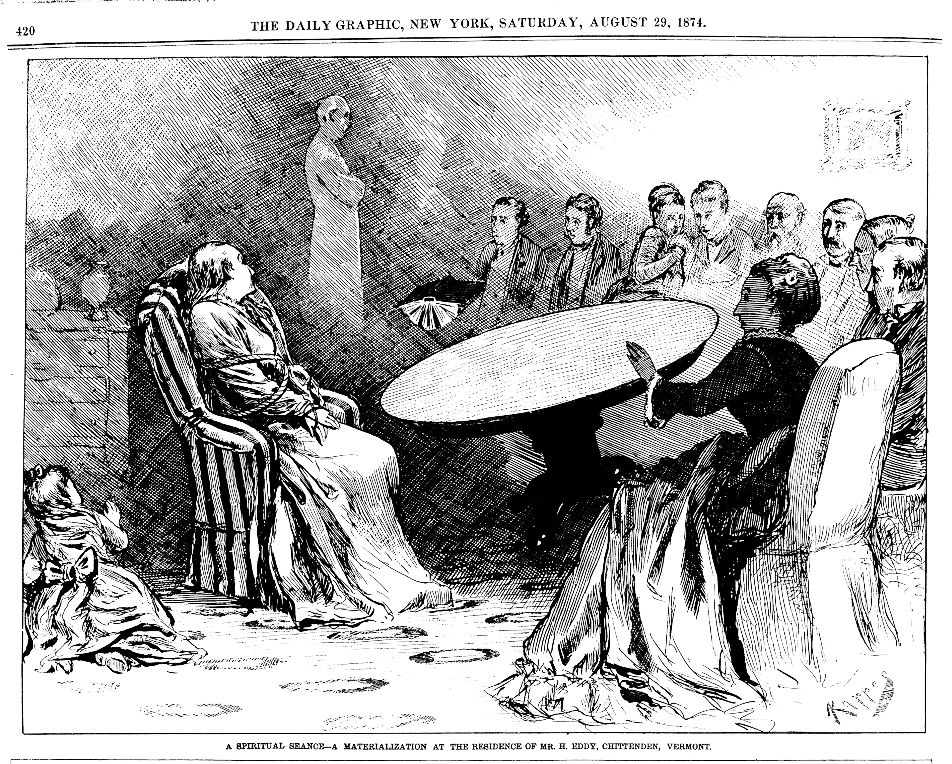
The 1870 census lists the human population of Chittenden, Vermont, as 802 souls including brothers William and Horatio Eddy, their sister Mary, and numerous other close relatives. From 1873 through 1875 the psychic population of the Eddy farmhouse was augmented by a plethora of “materialized spirits” such as “Honto” (a Native American maiden), “The Witch of the Mountain,” even Lord Byron, the famous poet who died in 1824. Guests attending a séance stood a good chance of also seeing the shades of departed loved ones, and many testified to exactly that.
Notable human attendees included Helena Blavatsky, a prominent Spiritualist who founded the Theosophical Society in 1875. The Theosophical Society, which is still active today, brings together persons who seek to integrate Eastern religious ideas with Western mysticism. Madame Blavatsky claimed descent from Russian royalty, traveled extensively, was fluent in a number of languages, and was deeply devoted to fostering an appreciation of the latent powers of the human mind such as those associated with hypnotism. Her approbation bestowed legitimacy on the Eddy family’s occult abilities.
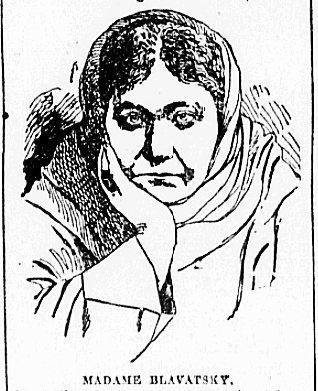
But skeptics constantly threatened to prove the mortality of spectral visitors through means of India ink sprayed from a concealed syringe, physical assault, even bullets. Were the Eddys perpetrating a massive fraud, or to avoid disappointment did they occasionally deceive their human guests when the spirits were uncooperative? Experts differed.
One such “expert” was Col. Henry Steel Olcott, a journalist who fought in the American Civil War, and who later served in the Department of the Navy in Washington, DC. His service garnered him sufficient respect that he assisted in the investigation of the assassination of President Lincoln.
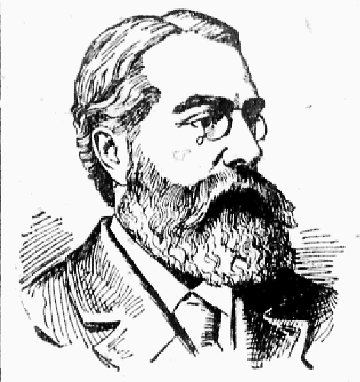
In 1874, on behalf of the New York Sun and The Daily Graphic (also of New York), Col. Olcott began investigating alleged psychic phenomena occurring at the Eddy homestead. An artist from The Daily Graphic accompanied him. Olcott chronicled his observations in a series of letters that he later compiled into a book, People from the Other World. Olcott ultimately came down in favor of occult practices to such an extent that he became the first president of the Theosophical Society and devoted the rest of his life to the study of religion and mysticism.
In his fifth letter, published on October 20, 1874, in The Daily Graphic, Olcott described the Eddy family thus:
The Eddys, we may say, live three distinct lives—one external, and one conscious and one unconscious internal life. The first is the common lot of us all; in the second they see spiritual things while otherwise in their normal condition, and remember what they see; the third is the state of deep trance, into which William, the greatest medium in history, invariably enters when sitting for the “materializations,” and into which Horatio and the others fall when obsessed by other spirits who communicate orally to their personal friends, or when levitated, or when sitting for powerful physical manifestations in the light or dark. Upon recovering from this latter condition the medium seems to remember nothing that has befallen him, except upon those rare occasions when William, like Epimenides and Corfidius, has left his body dead and wandered in the supernal spheres, bringing back accounts of what he had seen and heard among the immortals.
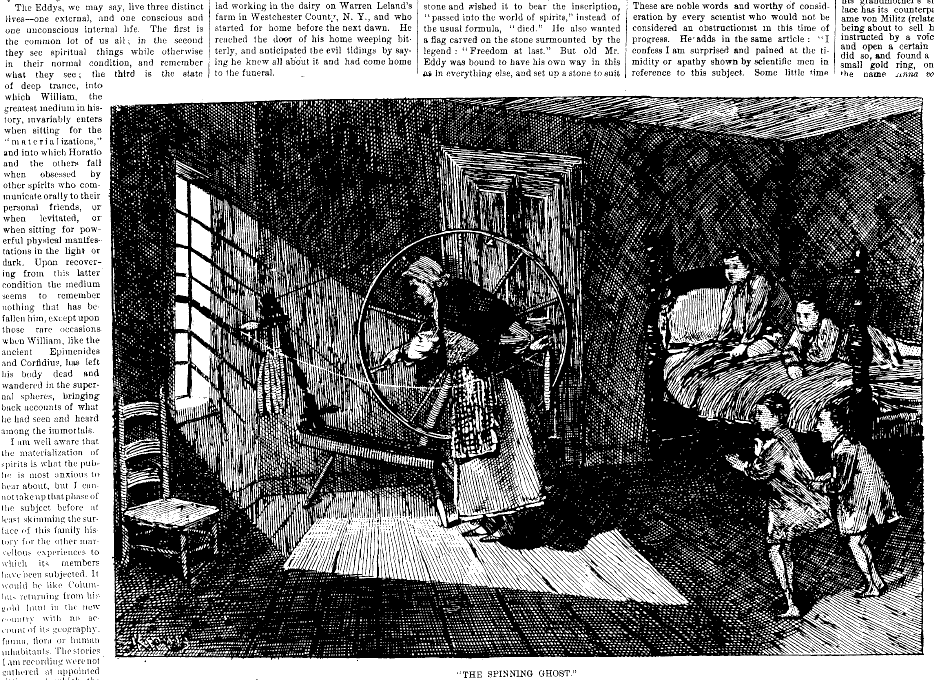
The séances took place in a long, rectangular room on the second floor of the Eddy farmhouse. At one end of the room a low stage was built with a railing at the front. Blankets or a small door with a diamond-shaped aperture screened the opening of an alcove or shallow closet (the “cabinet”) along the rear of the platform. The medium was usually tied to a small chair behind the curtain or door in a space not much larger than would accommodate his person, although sometimes two mediums were confined in that space.
An audience of perhaps two dozen people was seated on chairs and benches in front of the stage. Guests were asked to hold hands with those seated next to them in order to create the physiological energy or “battery” conducive to ghostly apparitions. A few of the people attending were either members of the Eddy family or associated with them; these people would conduct the ceremony and/or provide musical interludes throughout the evening. They also served as bodyguards to ensure that the séance was not disrupted. Since the Eddys lived in a rural area, guests would usually board with the family at eight dollars per week.
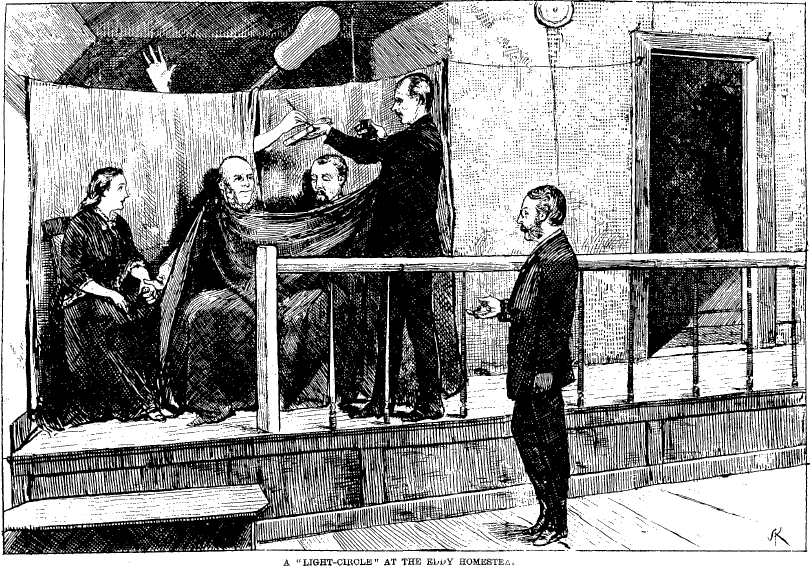
Ceremonies or “circles” could be either “light” or “dark,” which referred to the amount of light allowed in the room. In the former case, depicted above, select audience members were allowed to sit onstage with the medium while objects were thrown about or apparently floated in the air behind the curtain. Musical instruments seemingly played themselves, and disembodied hands appeared to write notes from the Great Beyond. Sometimes audience members were beaten with or struck by thrown objects. If the victims of this spiritual assault released their grasp on their neighbors’ hands in an effort to defend themselves, the physiological energy would vanish along with the avenging spirits.
During “dark” séances materialized spirits danced and responded to audience questions in various languages or by means of sharp raps or knocks that were interpreted to mean “yes” or “no.” Children as well as adults appeared, and many ethnicities were represented. Native Americans were frequent characters. Some spirits were armed. Some were drunk. Attractive female spirits sometimes received proposals for marriage, and often blew kisses to their admirers. There seems to have been an earthy streak in these unearthly visitations.
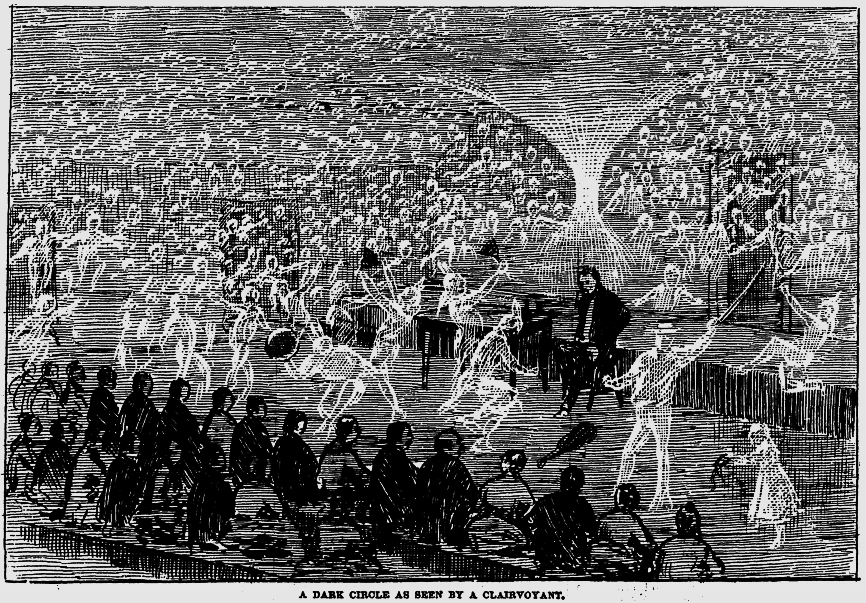
The materializations were not necessarily accepted at face value. Measurements of the room were taken. Floor boards were removed. Attempts were made to weigh the spirits. The medium’s pulse rate was measured before and after the shows. Col. Olcott was hardly alone in investigating the séances; neurologist George M. Beard collaborated with him in November 1874 to prove the materializations fraudulent. Dr. Beard praised Olcott’s diligent reporting and efforts to explain the proceedings without resorting to supernatural causes, but nonetheless claimed to have discovered the Eddys’ crude stratagems for deceiving their visitors. To him the illusions devolved to standard stage magic and careful selection of an audience predisposed in favor of Spiritualism. Dr. Beard justifiably included Col. Olcott in that category.
Of course, even the skeptics had skeptics:
Dr. Beard and the Eddys
I have just been reading Dr. Beard’s article relative to his recent visit to the Eddy family in Chittenden, and I must say I think him entitled to the respectful attention of all earnest-thinking minds upon the wide spread phenomena of ghosts and trances. He is without doubt sincere, at least I prefer to so regard him; and if he is able to produce such very remarkable illusions I deem him the worst enemy humanity ever had to contend with if he withholds public experiments, whereby all may learn the modus operandi. This writer has also visited the Eddy homestead; but, unlike G.M. Beard, M.D., was totally unable to fathom the mysterious presentations, except through the agency of departed beings. Believing thus, I am sure that there is more of life than the present. Disbelieving, I seek in vain for any proof whatever of immortality. Years gone by, while trying to believe in the vague theories of Bibleism and pronouncing Spiritualism a humbug, I experienced within my own organism, while entirely alone, many of those wonderful manifestations of an unseen power. I was not frightened, for I believe that God ordered them for my good. I must still so believe until Dr. Beard comes to my rescue.
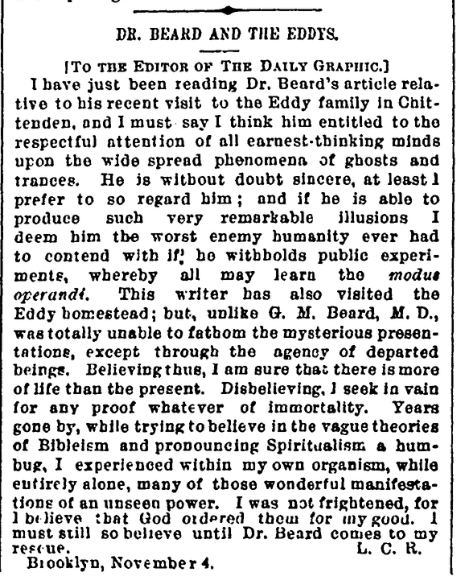
As much as they cultivated an unsophisticated audience predisposed to mystical excursions, the Eddys themselves were hardly the rubes and rustic farmers they claimed to be. Some members of the family avoided interacting with the public altogether, perhaps to allow them to impersonate ghosts without being recognized. William, Mary and Horatio did not volunteer that they had conducted séances in traveling shows for years prior to 1873, and had at times been exposed as frauds. In the item below from the Lowell Daily Citizen and News in 1869, Professor E.T. Carbonell proposed to expose “so-called” spiritual mediums including the Eddy family.

Surprisingly, Shaker communities turned out to be very receptive to supernatural experiences such as the Eddys provided. The Shakers had undergone their own spiritual awakening known as “Mother Ann’s Work” during the “Era of Manifestations” from about 1837-1860. Songs, drawings, and ecstatic dances were documented, blessings given, and visions bestowed upon otherwise sober, stoic adherents to that faith. Some of the Shakers’ most evocative and sublime creations including the familiar song “Simple Gifts” date to that time.
The following is an excerpt from an interview with Shaker Elder F.W. Evans discussing a visit to the Eddys in 1874. In it Elder Evans detailed Shaker spiritual experiences that weren’t publicized while they were occurring for fear of ridicule.
“For instance, one or two elders might be in the room below, and there would be a knock at the door, and the Indians would ask whether they might come in. Permission being given, a whole tribe of Indian spirits would troop into the house, and in a few minutes you would hear ‘whoop’ here and ‘whoop’ there all over the house.”
“But nobody in the rooms above had known that the elders had admitted the Indian spirits?”
“Nay. We only knew it who heard them ask permission to enter. But in a few minutes after permission was given everybody in the house would be obsessed. You would hear the men and women talking as if they were Indians. No theatricals that ever you saw on earth were equal to it. They would act out what they were simulating. They would sing new songs entirely unknown to our people, and sometimes they would sing in a foreign language that none of us knew. The mediums would converse together as if they were Indians, and not as themselves.”
“You never let the outside world know what was going on.”
“Nay indeed. What took place among us was so wonderful that it seemed incredible. And if we had published it to the world we should all have been sent to Bedlam.”
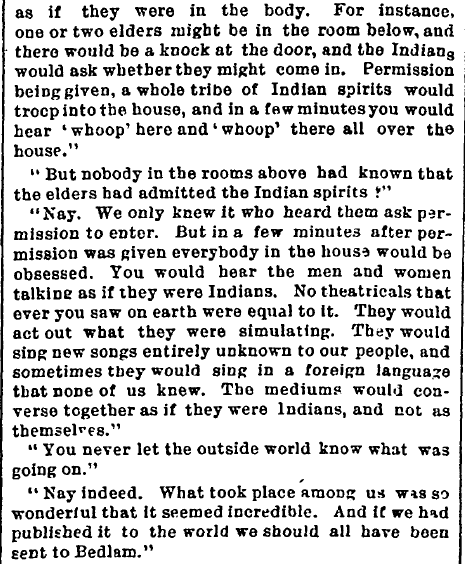
The beginning of the end came in 1875 when a materialization by a medium in Philadelphia of a female spirit named “Katie King” was exposed as a forty-year-old woman from Connecticut who had fallen on hard times, and who was prevailed upon by her landlords to impersonate a ghost in exchange for her room and board. Col. Olcott had vouched for the authenticity of Katie King, and his credibility was damaged when she was exposed as a fraud. A Vermont newspaper, The St. Albans Weekly Advertiser, described Olcott’s predicament:
Col. Olcott is in Philadelphia, convincing himself that Katie King was not a sham. He is attending seances held by Mr. and Mrs. Holmes, at which John King and Katie regularly appear. Olcott says that a ring was conveyed by the spirits from the cabinet to his room in the hotel and put under his pillow; that the genuine Katie appears and disappears in the air before the spectators’ eyes; and that all of the tests which he applies as a scientist (?) prove the reality of the manifestations. The woman who confessed to personating Katie King last fall proved to be a Mrs. White, about forty years old, and the wife of a saloon keeper in Winstead, Conn. She has not lived with her husband of late, and has assumed several different names. She says that she took a house in Philadelphia last March, and that Mr. and Mrs. Holmes boarded with her. Soon afterward they hired her to help in the spiritual exhibitions. The theory now held by Olcott, and by Gen. F.J. Lippitt, who is “investigating” with him, is that when the materialized Katie failed to appear, Mrs. White was introduced, and that the present manifestations are honest.
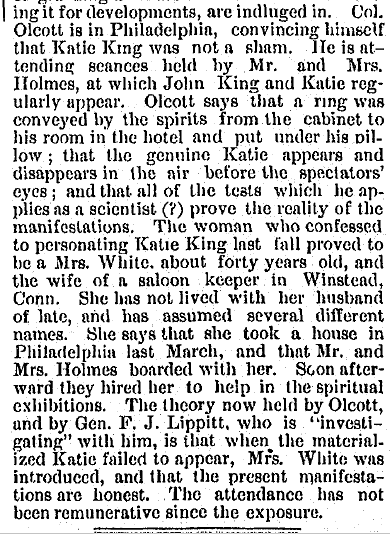
Late in the same year the New York Sun published an article revealing that a massive chimney situated in the Eddy farmhouse included an unused second flue that allowed access to the second floor spiritual “cabinet” from the kitchen below. The writer explained how the deceptions were carried out:
William goes down the materialized part of the chimney to the kitchen. There waiting for him are his two sisters, who are never seen in the circles, and the sister Alice, if the Lady of the Lake or an Arab boy, or spirits akin to these are to be represented, which representations are marked by the absence of Alice from the guests’ seats at the seance, or he meets anybody else who is engaged to take part in the farce of the evening. The programme has been arranged during the day as to the character to be represented. The costumes are in William’s room, which opens from the kitchen, and they are speedily donned, and the entertainment generally begins by one of the women going up the chimney into the cabinet, adjusting her dress and then stepping out from behind the army blanket on the stage to be wondered at, and perhaps recognized as one supposed to be quietly sleeping under the sod.
The sisters generally began the seance and William finished it, which allowed the women to get safely out of the house before the guests left the circle room. It is all simple and easy when understood. Its very simplicity has, however, been its greatest security. One can understand what a variety of characters could be shown by few bits of costume and a little false hair, when it is considered that the stage was darker than usual in the most melodramatic situation on the theatre boards, and the auditors were more than inclined to see with the eyes of sturdy faith. In fact, the costumes shown were very poor and commonplace, and evinced great lack of theatrical skill.
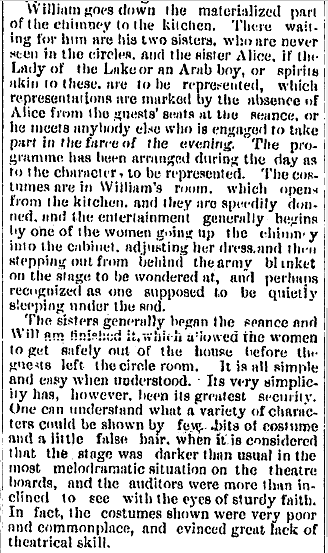
A writer for the New York Sun penned a satirical “farewell” reprinted on December 28, 1875, in the St. Albans Advertiser. It reads in part:
North Chittenden, Vt., Dec. 16.—The Eddy family, with the exception of Horatio and Mrs. Huntoon, have left Vermont. The little band of men, women and ghosts which for nearly two years has held almost nightly reunions in the now celebrated farm house at “Spirit Vale” is now disorganized and scattered. This important event is the result of two causes: The idea of another winter among the cold hills of central Vermont was distasteful to the spirits, most of whom have become acclimated to a much hotter region; and various circumstances, including a recent article in the Sun, have made the enterprise no longer profitable from a pecuniary point of view. Therefore William Eddy, after consulting with Brother-in-law Brown, summoned his sisters from the kitchen, Horatio from the barn yard, the several spirits from over the river, and, with ill-dissembled emotion, pronounced that the happy community must be dissolved.
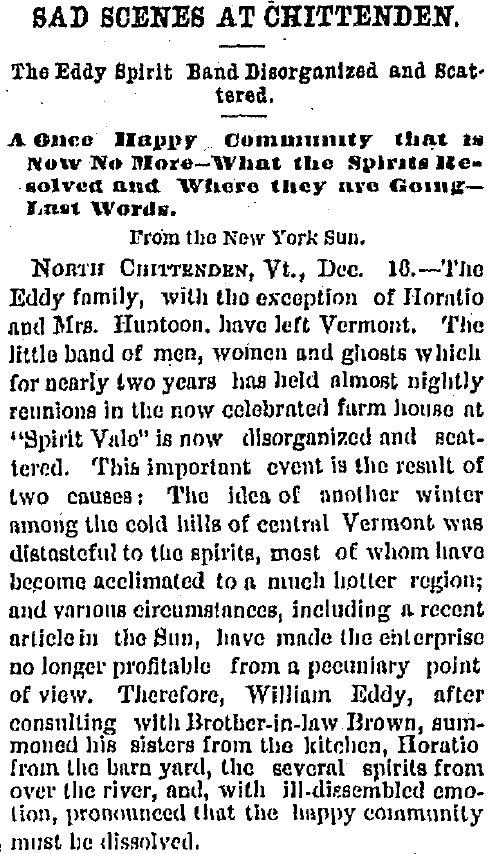
Remarkably the Eddy family returned to its roots, presenting séances in a traveling show with some success, notably in upstate New York. However, they were often harassed when they did appear or they were banned outright. While summarizing the conclusions of his investigation in November 1874, Dr. Beard suggested that the exposure of the Eddy family as frauds would make little difference to most recipients of that news:
First—The great majority of Spiritualists will be confirmed in their belief. Coleridge never stated a greater truth than this—that “it is of no use to undertake to reason anybody out of anything that they have never been reasoned into.” I see no reason why the Eddys may not continue to be as successful in their performances and in their audiences as before. It is one thing to overthrow folly by reason and another thing to convince fools that they are overthrown.
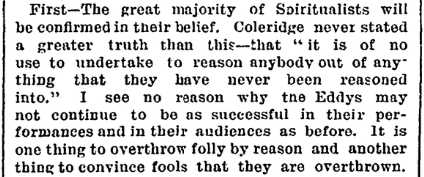
Col. Olcott embraced the uncanny and threw in his lot with Madame Blavatsky as the first president of her Theosophical Society. Eventually he found success as a leading Western authority on Buddhism.
And what of The Daily Graphic, that expended so much ink and newsprint on the rise of the Eddy family? In December 1874 its editor, likely David Goodman Croly, stepped out from behind his desk and confronted the onslaught of hopeful Spiritualist authors with his own instruments of transformation: a revolver and an outsized pair of scissors.
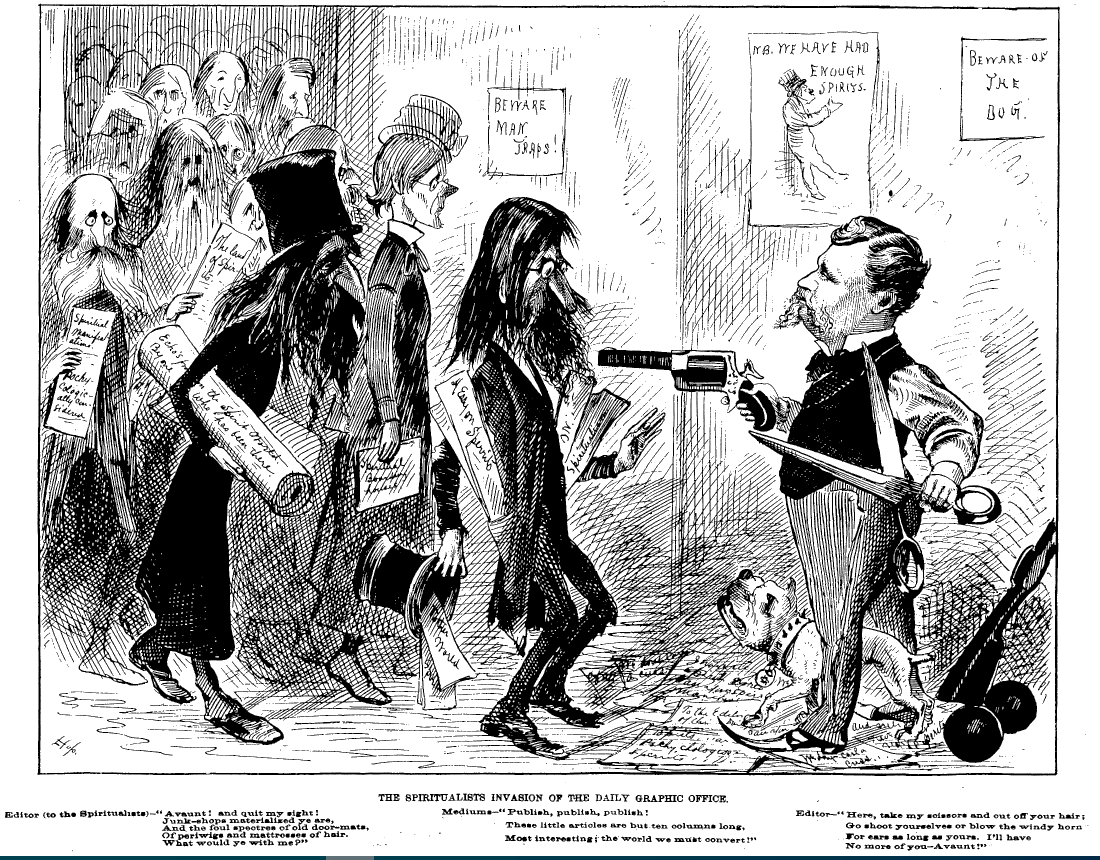
Editor (to the Spiritualists)
“Avaunt! and quit my sight!
Junk-shops materialized ye are,
And the foul spectres of old door-mats,
Of periwigs and mattresses of hair.
What would ye with me?”
Mediums
“Publish, publish, publish!
These little articles are but ten columns long,
Most interesting; the world we must convert!”
Editor
Here, take my scissors and cut off your hair;
Go shoot yourselves or blow the windy horn
For ears as long as yours. I’ll have
No more of you—Avaunt!”
To learn more about making Early American Newspapers available at your library, please contact Readex today.



